Tropicbirds, with their distinctive long tail streamers and striking plumage, are a captivating sight in tropical and subtropical regions around the world.
Belonging to the family Phaethontidae, these graceful seabirds are renowned for their elegant flight and aerial acrobatics.
With their elongated wings and buoyant flight patterns, tropicbirds effortlessly glide above the ocean waves, often venturing far from land in search of food.
Their vibrant white plumage, accentuated by bold black markings and flashes of color on their bills and tails, makes them a striking presence against the backdrop of azure skies and turquoise waters.
As iconic symbols of tropical paradises, tropicbirds enchant observers with their beauty and agility, embodying the spirit of exotic coastal environments.
Identifying Criteria of Tropicbirds
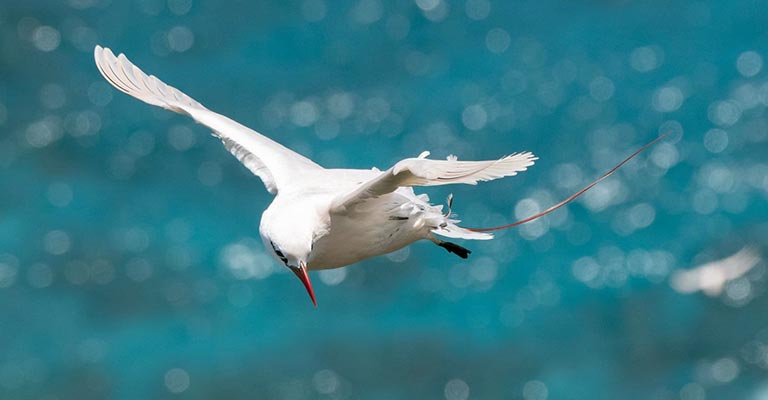
Identifying tropical birds amidst the vast expanse of tropical and subtropical waters requires attention to several key characteristics that set them apart from other seabird species.
Here are eight essential points to consider when identifying these graceful avians:
Distinctive Plumage
Tropicbirds are renowned for their striking plumage, characterized by predominantly white feathers contrasted with bold black markings.
Their long, slender wings and deeply forked tails contribute to their elegant appearance in flight, distinguishing them from other seabirds.
Long Tail Streamers
One of the most distinguishing features of tropicbirds is their long tail streamers, which extend beyond the length of their bodies.
These elongated feathers, often white or lightly colored, trail behind the bird during flight, creating a distinctive silhouette against the sky or ocean backdrop.
Brightly Colored Bills
Tropicbirds typically have brightly colored bills, which vary among species. While some may have red, yellow, or orange bills, others may exhibit hues of black or gray.
The bill shape is generally slender and pointed, well-suited for catching fish and other prey.
Graceful Flight
Tropicbirds are renowned for their graceful flight, characterized by smooth glides and occasional bursts of rapid wingbeats. They often soar effortlessly on warm air currents, executing intricate aerial maneuvers with precision and agility.
Distinctive Silhouette
When observed in flight, tropicbirds have a distinctive silhouette characterized by their long, slender bodies, elongated wings, and trailing tail streamers.
This silhouette sets them apart from other seabirds, making them easily recognizable even from a distance.
Habitat Preference
Tropicbirds are typically found in tropical and subtropical regions, frequenting coastal areas, offshore islands, and coral atolls. They prefer habitats with access to open ocean waters, where they can forage for fish and squid.
Vocalizations
While not always visible, tropicbirds may also be identified by their vocalizations. Their calls range from melodious whistles to harsh squawks, often heard during courtship displays or territorial interactions.
Behavioral Traits
Observing the behavior of tropicbirds can also aid in identification. They are skilled hunters, often seen plunge-diving from great heights into the water to catch fish and squid.
Additionally, their aerial acrobatics, such as looping flights and synchronized displays during courtship, are distinctive traits of tropicbirds.
By paying attention to these identifying criteria, birdwatchers, and enthusiasts can confidently recognize tropical birds in their natural habitats, appreciating their beauty and grace as they navigate the open skies and ocean waters of tropical regions.
Taxonomy of Tropicbirds
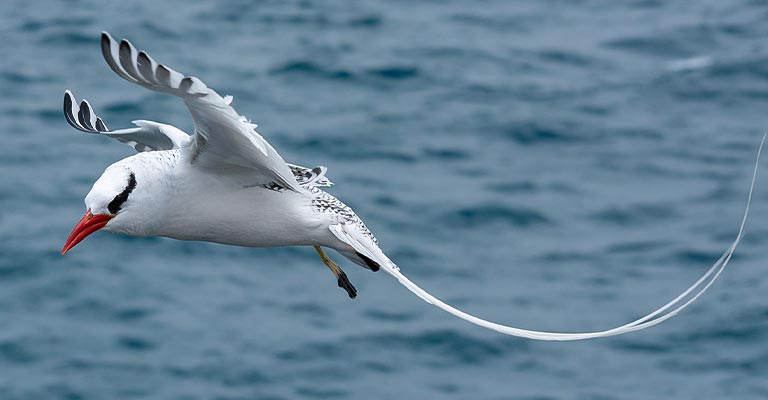
Below is the table detailing the taxonomy of Tropicbirds:
| Taxonomic Rank | Classification |
| Domain | Eukaryota |
| Kingdom | Animalia |
| Phylum | Chordata |
| Class | Aves |
| Order | Phaethontiformes |
| Family | Phaethontidae |
| Genus | Phaethon |
The Red-billed tropicbird (Phaethon aethereus), White-tailed tropicbird (Phaethon lepturus), and Red-tailed tropicbird are all closely related species belonging to the genus Phaethon within the family Phaethontidae.
While they share similarities in appearance and behavior, each species also possesses unique characteristics that distinguish them from one another.
Red-billed Tropicbird (Phaethon aethereus)
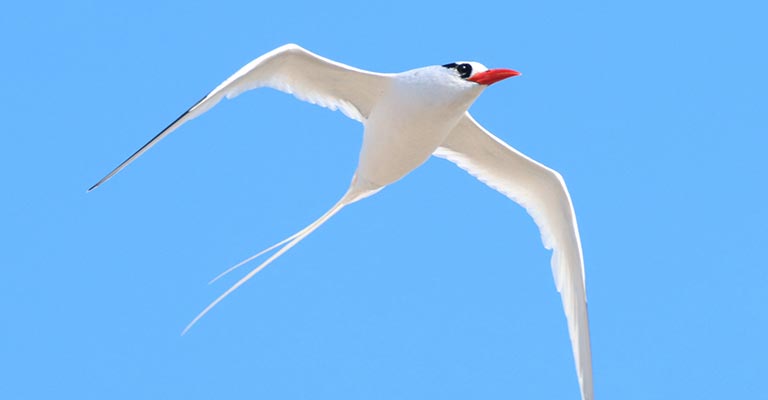
The Red-billed tropicbird is characterized by its vibrant red bill, which contrasts with its predominantly white plumage. It typically breeds on remote oceanic islands, where it constructs nests on rocky cliffs or in coastal vegetation.
During courtship displays, Red-billed tropicbirds engage in aerial acrobatics, with pairs soaring and diving in synchronized patterns. This species is known for its haunting calls, which echo across tropical seas as they forage for fish and squid.
White-tailed Tropicbird (Phaethon lepturus)
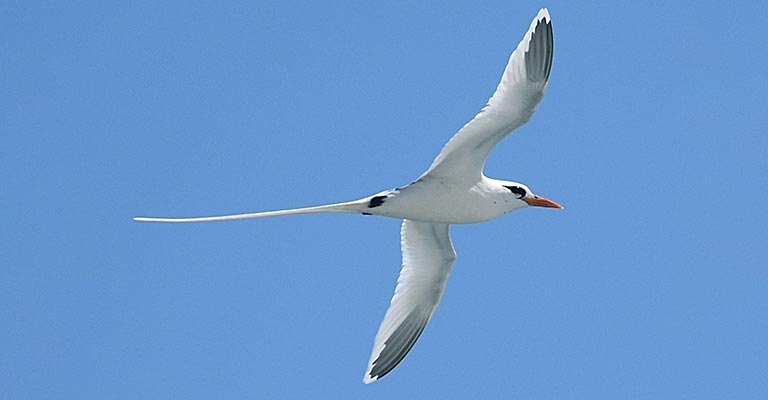
The White-tailed tropicbird is distinguished by its long, white tail feathers, which trail behind it in flight. It breeds on tropical islands and atolls, where it nests in crevices or burrows dug into sandy soil.
White-tailed tropicbirds are agile fliers, capable of executing rapid turns and dives as they hunt for small fish and squid near the ocean surface.
Their striking appearance and graceful flight make them a common sight in tropical waters, where they are often observed gliding effortlessly over the waves.
Red-tailed Tropicbird (Phaethon rubricauda)
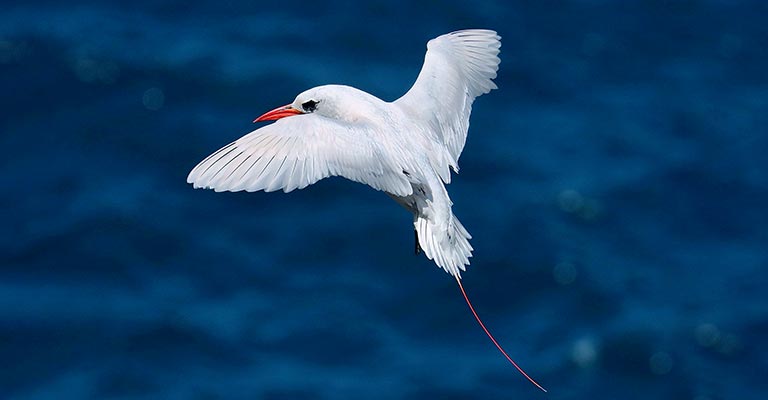
The Red-tailed tropicbird is named for its distinctive red tail feathers, which contrast with its white body and black markings. It breeds on islands and coastal cliffs, where it constructs nests using twigs, grasses, and other vegetation.
Red-tailed tropicbirds are skilled hunters, using their sharp beaks to catch fish and squid while plunge-diving from great heights. During the breeding season, males perform elaborate aerial displays to attract mates, showcasing their agility and strength in flight.
While these three species of tropicbirds share many similarities in behavior and habitat preferences, each possesses unique features that contribute to their individual charm and appeal in tropical and subtropical ecosystems.
Common Food of Tropicbirds
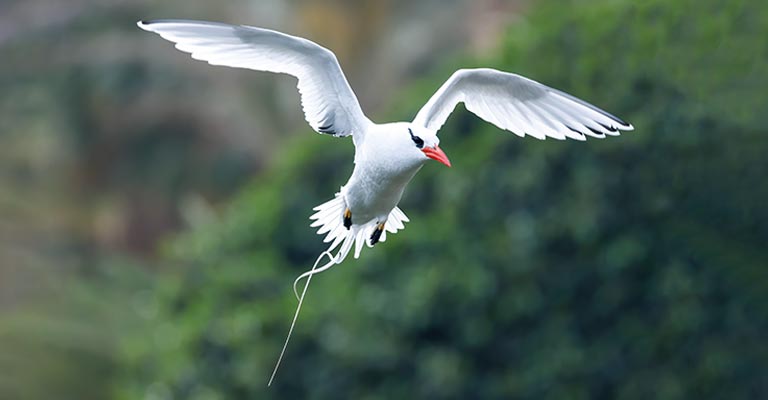
Tropicbirds primarily feed on a diet consisting of fish, squid, and other marine creatures found in tropical and subtropical waters.
Their hunting strategy often involves plunge-diving from great heights into the ocean to catch prey, utilizing their sharp beaks and agile aerial maneuvers. Common food items for tropicbirds include:
- Fish: Tropicbirds feed on a variety of fish species, including flying fish, sardines, and herring. They are adept at spotting fish swimming near the ocean surface and diving swiftly to capture their prey.
- Squid: Squid is another staple food source for tropic birds. These cephalopods are abundant in offshore waters and provide a nutritious meal for these seabirds.
- Crustaceans: Tropicbirds may also consume crustaceans such as shrimp and krill, particularly when other prey items are scarce.
- Small Pelagic Species: Additionally, tropicbirds may feed on small pelagic species like anchovies and small mackerel, which are plentiful in their oceanic habitats.
Their diet reflects their adaptation to life in marine environments, where they rely on their hunting skills to secure food and sustain themselves.
Tropicbirds Life History
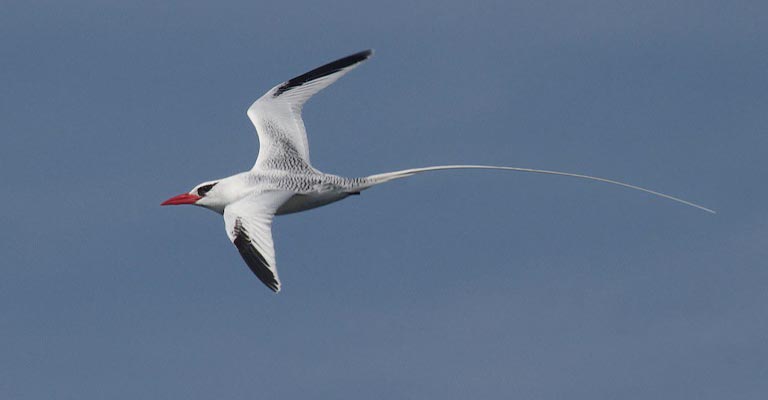
The life history of tropicbirds is a captivating tale of adaptation to coastal habitats and mastery of aerial environments.
From their hunting habits to nesting strategies and conservation challenges, tropicbirds exemplify the resilience and beauty of avian life in tropical and subtropical regions.
Hunting Habit
Tropicbirds are skilled hunters, primarily feeding on fish and squid. They employ plunge diving as their primary hunting technique, soaring high above the ocean before diving headfirst into the water to catch their prey.
Their long wings and streamlined bodies facilitate swift and precise movements underwater, allowing them to capture food with remarkable efficiency.
Habitat
Tropicbirds inhabit tropical and subtropical regions around the world, favoring coastal areas, offshore islands, and coral atolls.
They are often found in proximity to warm ocean currents, which provide abundant food sources such as fish and squid. Remote cliffs and rocky outcrops serve as ideal nesting sites, offering seclusion and protection from predators.
Range Map

The range of tropicbirds varies among species, with some found in the Atlantic, Pacific, and Indian Oceans. Their distribution is influenced by factors such as food availability, nesting habitat, and oceanic currents.
Tropicbirds are typically found in regions with warm, tropical climates, although some species may venture into subtropical or temperate zones during migration.
Nesting
Tropicbirds nest on remote cliffs, offshore islands, or coral atolls, often in colonies with other seabird species.
They construct simple nests using twigs, grasses, and other available materials, typically placed on ledges or in crevices for protection. Nest sites are carefully selected for their accessibility and proximity to food sources.
| Nesting Details | Tropicbirds |
| Clutch Size | Usually 1 egg |
| Number of Broods | Typically 1 per year |
| Egg Length | Approximately 6-8 cm |
| Egg Width | Approximately 3-5 cm |
| Incubation Period | Around 4-6 weeks |
| Nestling Period | Approximately 8-12 weeks |
| Egg Description | Smooth, glossy surface; white with light brown speckles |
| Nest Description | Simple nests made of twigs, grasses, and other vegetation, usually placed on rocky cliffs or offshore islands. |
Breeding
Breeding season for tropicbirds typically occurs in the warmer months, with pairs engaging in elaborate courtship displays to attract mates. Mated pairs work together to incubate eggs and care for chicks, with both parents sharing parental duties.
Chicks are precocial, meaning they are relatively mature and mobile shortly after hatching, although they still rely on their parents for food and protection.
Diseases and Treatment
Tropicbirds may be susceptible to diseases and parasites, particularly those transmitted through contaminated food sources or environmental factors. Common ailments include avian botulism and respiratory infections.
Treatment often involves supportive care, such as providing fluids and antibiotics administered by wildlife veterinarians and conservationists.
Conservation
Tropicbirds face various conservation challenges, including habitat loss, pollution, climate change, and predation by invasive species. Conservation efforts focus on habitat protection, reducing human disturbances near nesting sites, and monitoring population trends.
Collaborative initiatives involving government agencies, non-profit organizations, and local communities are crucial for the long-term conservation of tropical birds and their habitats.
10 Behavioral Habits of Tropicbirds
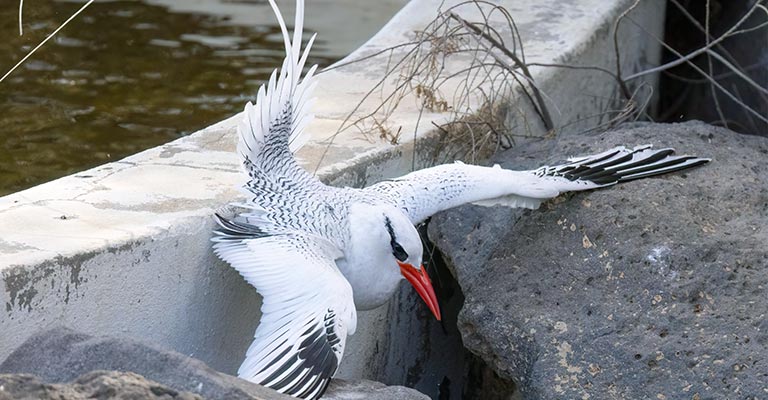
Tropicbirds, with their stunning plumage and graceful flight, exhibit a fascinating array of behavioral habits that reflect their adaptation to life in tropical and subtropical regions.
Here are 10 intriguing insights into the behavioral repertoire of these captivating seabirds:
Aerial Mastery
Tropicbirds are renowned for their exceptional aerial skills, effortlessly soaring and gliding on warm oceanic currents. Their long, slender wings and deeply forked tails enable them to navigate the open skies with precision and agility.
Courtship Displays
During the breeding season, tropicbirds engage in elaborate courtship displays, which involve aerial acrobatics, synchronized flights, and vocalizations. These displays strengthen pair bonds and help establish territories.
Nesting Behavior
Tropicbirds typically nest on remote, rocky cliffs or offshore islands, where they construct simple nests using twigs, grasses, and other available materials. Nest sites are often selected for their seclusion and protection from predators.
Monogamous Pairing
Tropicbirds are predominantly monogamous, forming long-term pair bonds with a single mate. Mated pairs engage in cooperative behaviors such as nest building, incubation, and chick-rearing.
Parental Care
Both parents participate in incubating the eggs and caring for the chicks after hatching. They take turns feeding and guarding the nest, ensuring the survival of their offspring.
Feeding Techniques
Tropicbirds primarily feed on fish and squid, which they capture by plunge-diving from the air or by skimming the water’s surface with their bills.
Their keen eyesight and aerial prowess enable them to detect and pursue prey with remarkable accuracy.
Colonial Nesting
Some species of tropicbirds nest in colonies, gathering in large numbers on remote islands or coastal cliffs during the breeding season. These colonies provide safety in numbers and facilitate communal defense against predators.
Territorial Behavior
Tropicbirds exhibit territorial behavior, especially during the breeding season when competition for nest sites and food resources intensifies. Aggressive displays, vocalizations, and aerial chases are common forms of territorial defense.
Migration Patterns
While some tropicbird species are sedentary, others undertake seasonal migrations between breeding and wintering grounds. These migrations are driven by changes in food availability and environmental conditions.
Social Interactions
Tropicbirds are social birds, often gathering in loose flocks outside of the breeding season. These gatherings provide opportunities for socializing, mate selection, and foraging cooperatively in productive feeding areas.
The behavioral habits of tropicbirds reflect their adaptation to life in tropical and subtropical environments, characterized by aerial mastery, intricate courtship rituals, and cooperative breeding strategies.
By understanding these behaviors, we gain deeper insights into the fascinating lives of these charismatic seabirds and the ecosystems they inhabit.
Wrapping Up
Tropicbirds epitomize the allure and mystique of tropical ecosystems, captivating observers with their elegance and grace.
From their distinctive appearance to their remarkable aerial displays, these seabirds embody the spirit of exotic coastal environments. As ambassadors of the tropics, tropicbirds inspire awe and reverence, symbolizing the beauty and biodiversity of remote island habitats.
Their presence serves as a reminder of the interconnectedness of all living beings and the importance of preserving fragile ecosystems.
By understanding and appreciating the fascinating life history of tropical birds, we can foster greater awareness and conservation efforts to safeguard their future and the diverse marine environments they call home.